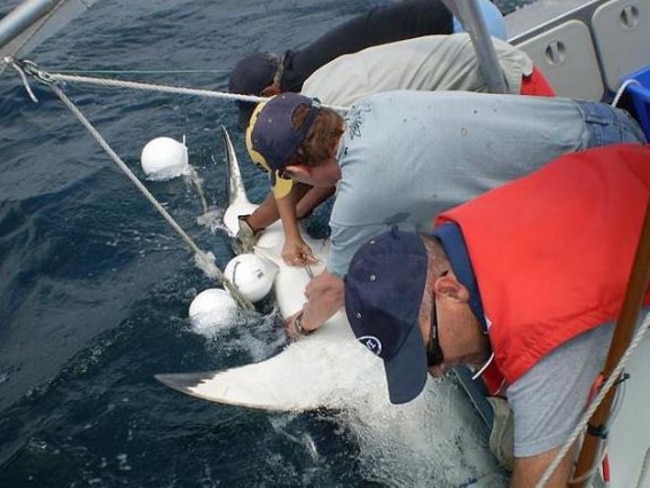Secrets of the great white start to surface with up to 1200 patrolling Australia’s eastern coast
RESEARCHERS have put a figure on the population of great white sharks for the first time.

Tasmania
Don't miss out on the headlines from Tasmania. Followed categories will be added to My News.
RESEARCHERS from Tasmania have used breakthrough genetic testing to put a figure on the population of great white sharks for the first time.
CSIRO scientists have released a groundbreaking report that estimates there are 750-1200 adult great whites in eastern Australian coastal waters.
The research comes as Tasmania continues to come to terms with last weekend’s first shark fatality in 22 years.
Kingston man Damian Johnson, 46, was killed last Saturday morning as he dived for scallops near Lachlan Island in Mercury Passage.
Another attack on a surfer in northern NSW on Friday took the number to eight across Australia in the past 18 months.
Great white numbers and behaviour have largely been a mystery to scientists, who have relied on difficult and expensive tagging programs in the past.

But a team from the National Environmental Science Programme, led by Hobart-based Barry Bruce, is claiming a first in putting a number on the species.
Dr Bruce said the numbers remained provisional and the total population would be higher if juvenile sharks could also be counted.
“But as we get more samples, [adult] numbers are tending towards the lower end of this range,” he told the Sunday Tasmanian.
“The number is smaller than we thought it may be — but without knowing what the number was in the past, the significance of this is hard to tell.
“What it does not yet tell us though, is whether the population is going up or down.”
The team used a DNA fingerprinting technique available only in the past five years to identify sibling relationships, a method evolved from the management of the southern bluefin tuna fishery.
Scientists have found the eastern population of great whites, which includes that of Tasmania, does not interact with a separate population west of Bass Strait.
The eastern great whites can migrate from Tasmania and Victoria as far north as southern Queensland in winter, and have been tracked to New Zealand.
Southern Cross University shark expert Danny Bucher said that, in theory, the giant sharks followed the migration north of humpback whales and large fish on spawning runs.
“Perhaps it’s following along hoping for an easy meal. There are old whales, young whales that suffer during the trip and are a bit weak and die,” Dr Bucher said.
The humpback population has returned to close to pre-whaling levels but that doesn’t mean great whites, considered a vulnerable species and protected nationally since 1999, have dramatically increased in number.
While game fishing for them has been outlawed, Dr Bucher said they were still being snared in beach mesh, taken as by-catch and caught illegally for their fins.
Some anecdotal evidence existed that the numbers of younger sharks could be increasing, he said.
Great whites are indisputably the world’s most dangerous sharks, but researchers argue the increase in attacks is proportional to the number of people using the water.

Not all large sharks migrate north, and the seal colonies around the Tasmanian coast could one reason for staying, Dr Bucher said.
“The danger with great whites is they’re not going to hesitate if they see a human because we’re about the right size for a seal,” he said.
“They know we’re not a seal but we’re about the same size and we certainly don’t swim as well as seals.
“A big one, particularly, won’t hesitate.”
With surfers the most at-risk group, new electronic repellents are being developed, but they are yet to be proved 100 per cent effective. Scientists argue better detection and warning systems using new technologies should replace beach meshing but Dr Bruce said there was no foolproof way to prevent shark attack.
“White shark movements in Australia tend to be more along the coast than we see in other parts of the world and it is not unusual for them to be close to shore,” he said.
“Understanding that entering the sea will never be risk-free is important — it never has been risk-free.
“But of all risks in entering the sea, the risk of being bitten by a shark is pretty low.”
david.beniuk@news.com.au


